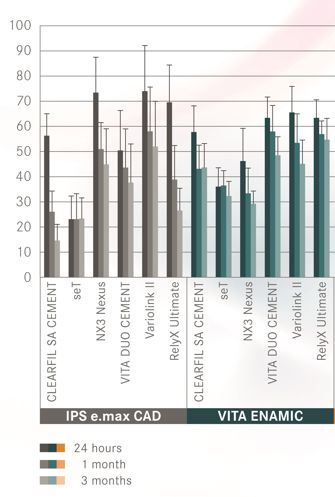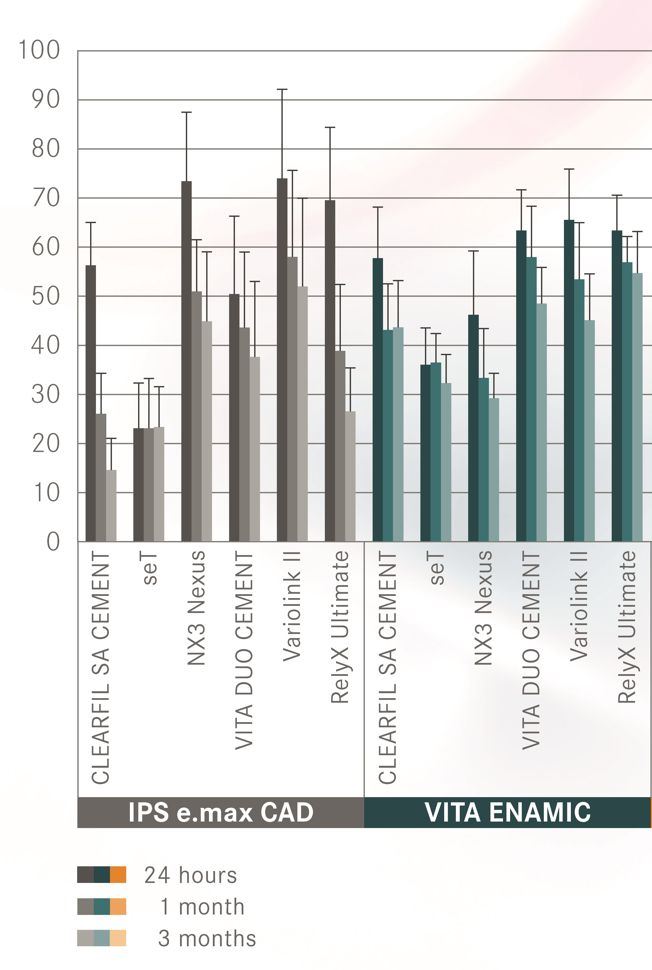Bonding resilience between luting composites and hybrid ceramics as well as glass ceramics
For the clinical long-term durability of ceramic restorations, a resilient and reliable bond between the luting composite and the ceramic is of great importance. In the following interview, Dr. Tian Tian reports on her findings from an investigation on the microtensile adhesion strength of six luting composites to the hybrid ceramic VITA ENAMIC and the glass ceramic IPS e.max CAD.
DV: Dr. Tian, what conclusions can be drawn from the test results on the bonding resilience of luting composites to glass or hybrid ceramics in clinical use?
Dr. Tian Tian: The results of the investigation show that the selection of bonding material is a decisive factor which strongly impacts the long-term resistance of ceramic restorations. In all tested combinations of bonding and restoration material, a decrease in the adhesive strength was observed over time. Here, the initial adhesion values obtained are significantly different from the adhesion values after artificial aging depending on the luting composite used.
DV: For which combinations of materials were particularly high bond strength values measured, and for which combinations were they relatively low after three months of storage?
Dr. Tian Tian: After three months of storage in water, the highest adhesion strengths were determined for Variolink II (Ivoclar Vivadent, Schaan, Liechtenstein) in combination with glass ceramics. The same luting composite achieved the highest initial values with VITA ENAMIC; however, after aging, RelyX Ultimate (3M ESPE, St. Paul, USA) showed slightly better results. The lowest bond strength after three months of storage in water was measured, depending on the restoration material, with various cements.
DV: Did you observe significant differences between the material classes of glass and hybrid ceramics with regard to the adhesion to bonding materials?
Dr. Tian Tian: Similarly high adhesive strengths were obtained for all classes of materials after aging in water. There was a difference in the type of failure. In the hybrid ceramics group, it was most frequently a cohesive failure that was detected, while in the glass ceramics, it was predominantly mixed cases of failures and adhesion failures that occurred. When cohesive failures are observed, it means that the failures did not happen at the interface between the ceramic and the adhesive material. In this case it is not possible to state the actual bond strength.
DV: What are the minimum values that should be achieved in tests, so that clinicians can expect a resilient bond of the luting composite to the ceramics?
Dr. Tian Tian: A durable bond is dependent on many factors and must be proven by various laboratory studies and clinical tests. The determination of microtensile bond strength is one of many methods with which adhesion can be determined. It is not reasonable to give a minimum value to be achieved. It is important to compare groups within the same study (with identical test conditions). The following applies: The longer the storage, the more significant the results are for users.
DV: Have you observed any cases of debonding in your investigation with glass and hybrid ceramics?
Dr. Tian Tian: No individual case of debonding was found during the whole test. This result indicates that the adhesion between the tested luting composites and the glass ceramic IPS e.max CAD as well as the hybrid ceramic VITA ENAMIC was still relatively strong after three months of storage in water.
DV: Are there combinations of bonding and restoration materials that you would assess as especially suitable for clinical use on the basis of the test results?
Dr. Tian Tian: The results of this investigation show that Variolink II attained a very high adhesive value with all three ceramics after three months of aging in water. In order to make general statements about the long-term durability of the adhesion between luting composites and glass or hybrid ceramics, however, additional studies with longer aging and additional clinical studies are necessary.
Report 09/15
Source: University of Hong Kong, Dental Faculty, Department of Dental Material Sciences,
Dr. Tian Tian et al., Hong Kong, China; 03/2015
Note: Test report published as poster abstract "Evaluation of bonding durability between CAD/CAM ceramics and resin cement“ IADR 2013, Boston, USA



